Here is a list of FAQs on the NRC and details of the various issues involved.
An earlier story by Factly answered a few questions about the much-debated Citizenship Amendment Act 2019 (CAA). In this story, we address a few questions related to National Register of Citizens (NRC) and what may happen if the NRC is implemented across the country.
It has to be noted that the rules for implementation of CAA are yet to be released by the government. At the same time, there is no further information on the nationwide NRC except for the statements of the Home Minister, BJP leaders and some FAQs released by the Ministry of Home Affairs (MHA).
What is NRC?
National Register of Citizens is a register which contains the names of citizens. Names of citizens are entered in the list on verifying the documents produced proving their citizenship. Section 14A of the Citizenship Act specifies that the Central Government may maintain a register of citizens and issue national ID cards to all of them.
The Section 14A that introduced the concept of NRC was included in the Citizenship Act through an amendment notified in 2004. This amendment was passed by both houses of parliament during the Vajpayee led NDA government in 2003 and was notified after the UPA came to power in 2004.

The Citizenship (Registration of Citizens and Issue of National Identity Cards) Rules, 2003 lays out the procedure to prepare and maintain the NRC. The exercise is to be done under the supervision of the Registrar General of Citizen Registration.
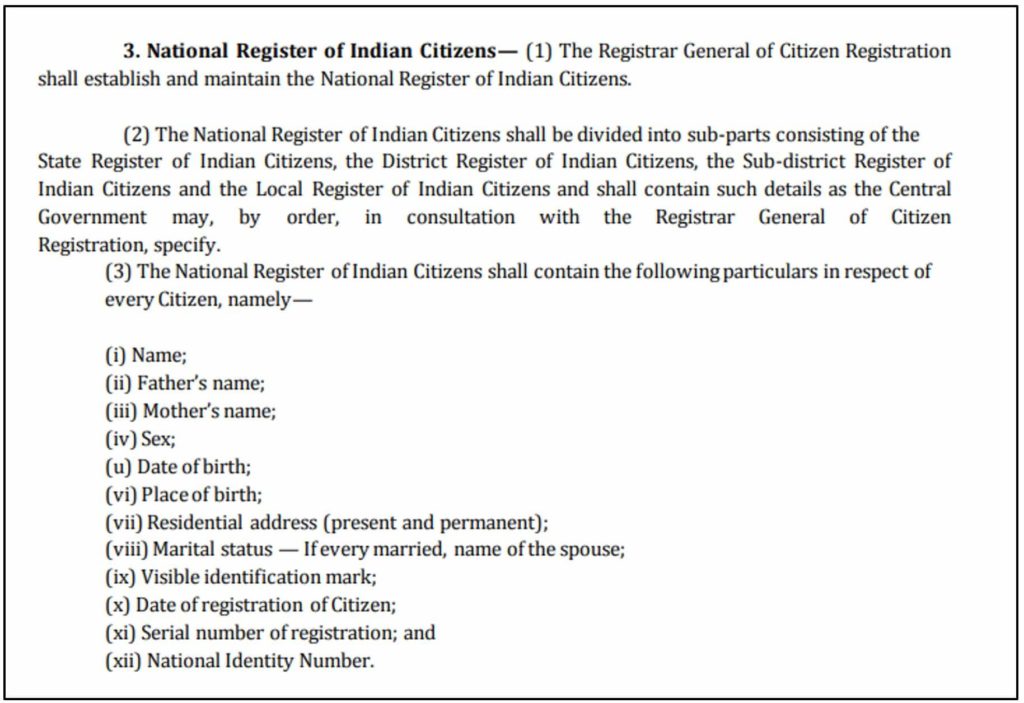
When was it first prepared?
The NRC Assam, the register containing names of Indian Citizens in Assam, was prepared in 1951 as a non-statutory process by recording particulars of all the persons enumerated during 1951 Census. This was done before the enactment of the Citizenship act of 1955. The registers were kept in the offices of Deputy Commissioners and Sub Divisional Officers.
As per the Supreme Court’s directions, the exercise of NRC update in Assam commenced in December 2013 to be completed over a period of three years. This exercise was to weed out illegal migrants who posed a threat to the demography of the state and was done as part of the Assam Accord.
What is the Assam Accord?
The Assam agitation (1979-85) against the illegal foreigners led to the signing of Assam Accord on 15 August 1985, between the Central Government, State Government, All India Students’ Union (AASU) and All Assam Gan Sangram Parishad (AAGSP), which stipulated 24 March 1971, as the cut-off date for identification and deportation of illegal migrants from East Pakistan (Bangladesh). Accordingly, the Citizenship Act, 1955 was amended by inserting Section 6A as a special provision for Assam.
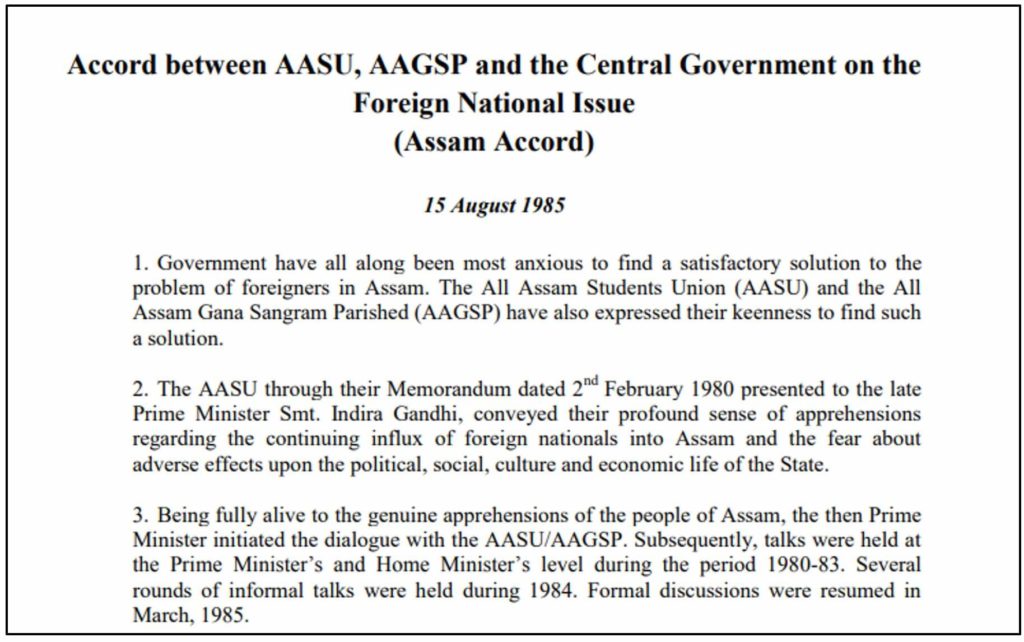
In a tripartite meeting of the Central Government, State Government and AASU chaired by the Prime Minister in May 2005, it was agreed to update NRC of 1951. The modalities were approved by the Government of India in consultation with the Government of Assam.
Assam Accord is the Memorandum of Settlement signed between Rajiv Gandhi led Central Government and the leaders of the popular Assam Movement in 1985. The movement was against the illegal migrants, mainly from Bangladesh, who settled down in Assam.

Section 6A of Citizenship Act specifies the provisions concerning citizenship of persons as per the Assam Accord of 1985. According to Assam Accord and Section 6A of the Citizenship Act,
- Those who entered Assam prior to 1966 are deemed, legal citizens.
- Those who entered between 1966 and 24 March 1971 had to register themselves as foreigners and were eligible to vote in elections after ten years.
- Appropriate action was to be taken against those who entered Assam on or after 25 March 1971, as per relevant laws and be deemed as illegal migrants.
What happened in Assam while carrying out NRC exercise?
The NRC exercise carried out in Assam required residents of Assam to prove their presence in the country or linkage to someone whose name was a part of the electoral rolls up to 24 March 1971. The list of documents that can be used as proof to establish linkage or presence back to 1971 has been listed on the official website.

List A is that list of documents one can use to establish the presence of ‘ancestor or self’ on or before 24 March 1971. These documents had to be issued before the midnight of 24 March 1971. List B is those documents one can use to establish a relationship with the ancestor whose documents were submitted as per List A. Documents in List B are not required to be submitted if one has submitted any document in List A for self.

The draft NRC published in 2018 had left out the names of 40 lakh people. The revised final list was published in August 2019 which left out the names of over 19 Lakh people.
As per media reports, many government employees, family members of the former President of India were also among those who were excluded from the NRC Assam. The BJP leadership in Assam has also expressed dissatisfaction with the outcome of the NRC exercise in Assam as did the other political parties.
What is the cost of Assam NRC?
The Government of India, which funded NRC project in Assam released a total of Rs.1220.93 crore as of December 2018. The details of the total cost of the NRC exercise in Assam are not known yet.
Why is NRC being linked with CAA protests?
While there is no official announcement or a notification from the government about a nationwide NRC, the Home Minister and other BJP leaders have made statements about such an exercise and also about the relation between CAA & NRC.
It is also worth noting that various leaders of BJP spoke in different voices at different times on whether or not NRC and CAA are related.
On 09 December
2019, Home Minister Amit Shah mentioned in the
Lok Sabha during the discussion on CAB, that
NRC will be implemented in the country.

Even in April 2019, Amit Shah can be seen stressing on implementation of CAB and NRC in the same order in a video uploaded on BJP’s official channel on YouTube,
Now, there have also been reports of Union Ministers Ravi Shankar Prasad and Nirmala Sitharaman stating that there is no relation between CAA and NRC.
A tweet on nation-wide NRC as stated by Amit Shah was made by the BJP’s official twitter handle on 11 April 2019. But this tweet was subsequently deleted.
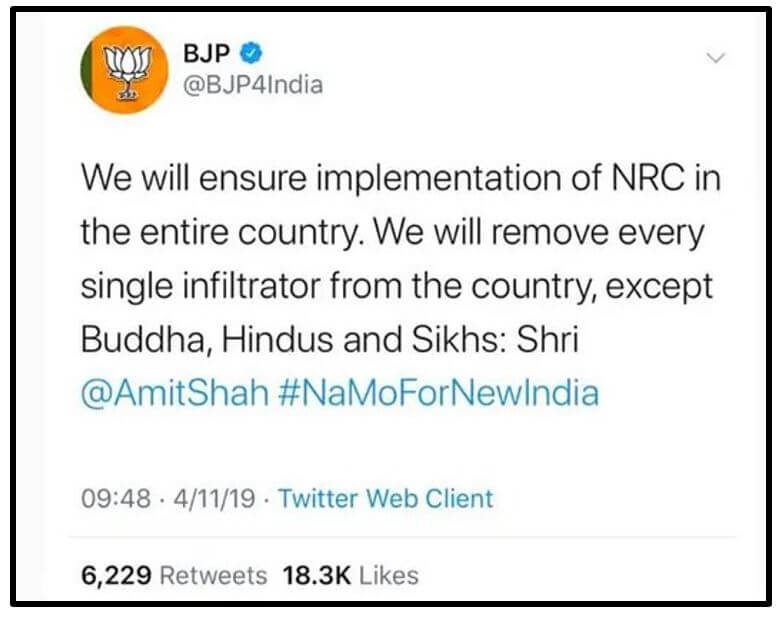
Amidst all this, the Prime Minister in his speech on 22 December 2019 stated that NRC was not even discussed within the government since he took over as the Prime Minister in 2014.
A tweet by the Official Spokesperson of MHA was later deleted
In a bid to clarify some common doubts, the official spokesperson of the Ministry of Home Affairs (MHA) made a series of tweets on the issue. In one of those tweets, it was mentioned that the list of documents accepted for any future NRC exercise is likely to include a lot of common documents.
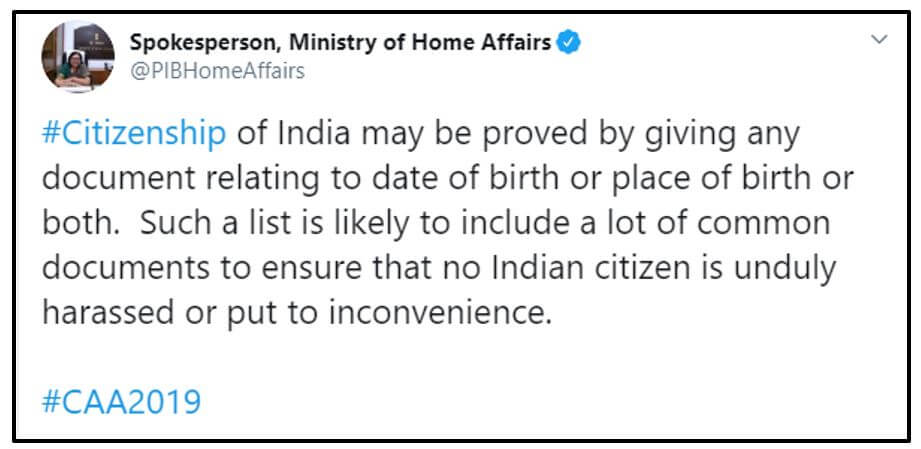
A tweet in the same thread also mentioned that there would not be any need to establish ancestry by presenting identity cards of parents or grandparents. However, the tweet was later deleted.
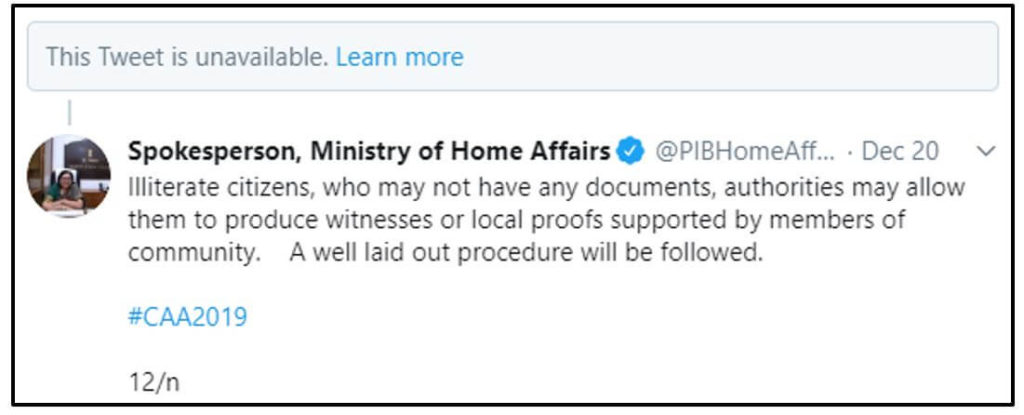
This tweet was however found in archives.

The Home Ministry’s FAQs on NRC
Subsequently, a series of FAQs were published by the Press Information Bureau (PIB). In these FAQs, the following is mentioned about the need to provide details of the birth of one’s parents.
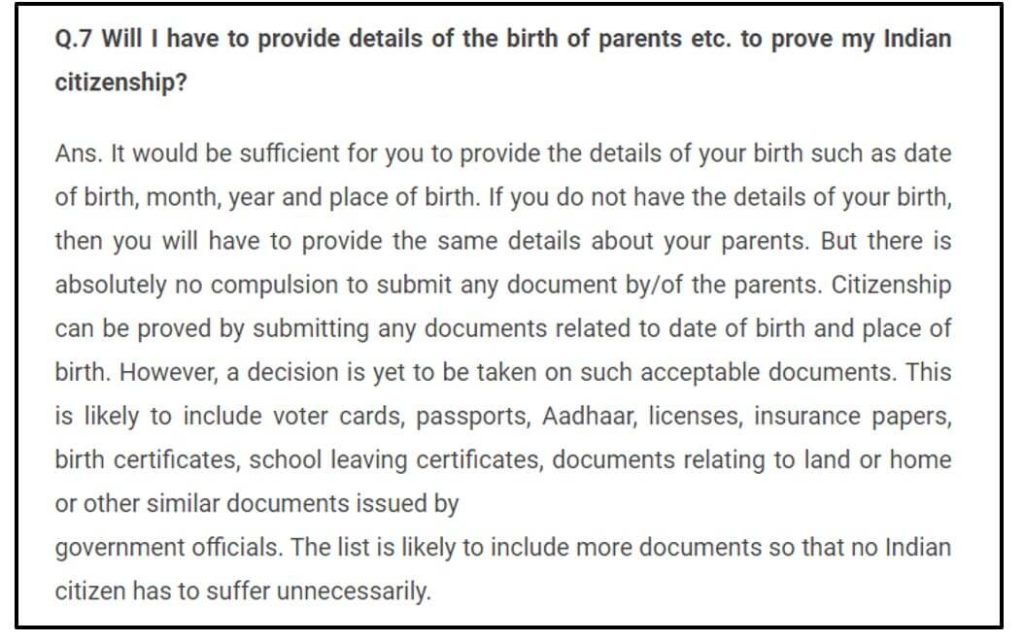
However, multiple other documents that are commonly used by most of us are issued only to citizens. Whether these documents will be accepted for any future NRC exercise and what will be the cut-off date are still not known.
For instance, only Indian citizens can vote in elections. The Voter ID is a document which establishes one’s citizenship since being a citizen is one of the prerequisites for enrolling as a voter. A citizen will have to fill up Form 6 to get their name included in the electoral rolls. However, only those aged above 18 years will be eligible for the same. Another proof of citizenship is the Indian Passport, which only a small fraction of citizens hold.
It should be noted that Aadhar card is not proof of citizenship since it is issued to all residents of India and not just citizens.

Is there a link between CAA & NRC?
There have been instances when the Home Minister stressed on implementing a nation-wide NRC after passing the Citizenship Amendment Bill in that order. However, BJP leaders are now claiming that both are not related.
Technically, the CAA & NRC serve two different purposes and there is no apparent link between the two. Through the NRC, the government aims to identify infiltrators who have been living in the country illegally.
With the CAA in place, the following are some of the possibilities.
- The migrants belonging to the six religions from the three countries will not be affected if they can prove that they come to India because of religious persecution. They will not be deemed illegal migrants even if they do not possess necessary documents. How does one prove religious persecution remains unanswered since the rules & process for the implementation of the CAA are yet to be framed.
- Migrants belonging to other religions, including Muslims, may be considered illegal migrants if they do not possess relevant documents. The CAA will not come to their rescue unlike in the case of persons from the 6 minorities.
- Those migrants from the specified countries and religions who may not be able to prove that they fled because of religious persecution will also be deemed illegal migrants and will not get relief with the CAA.
- Those migrants from other countries (other than the three mentioned in the CAA) will be excluded from NRC if they have not acquired citizenship through naturalization.
- There is also fear that the Muslims and even Hindus in India who cannot produce adequate proof of citizenship will be considered illegal migrants if & when NRC is undertaken. However, some Hindus who can trace their lineage to the three nations (Pakistan, Afghanistan & Bangladesh) may get relief with CAA.
What are the reasons behind the protests?
The protests across the country seem to be for varied reasons.
- The unrest in North-Eastern states have been attributed to the possibility of cultural erosion and large influx of migrants irrespective of religion. Assam fears that the law would nullify the Assam accord.
- Exclusion of certain sects of Muslims from these three countries who are also persecuted is another reason for protests. The opposition and some experts have said that the CAA is violative of Article 14 thereby rendering it unconstitutional. However, some other well-known jurists have argued that the CAA does not violate Article 14. This will now be decided by the Supreme Court.
- Fear of combining NRC and CAA is another reason for protests.
- Possible alteration to the demography and the effect on opportunities to locals is also a cause for apprehension. As already seen above, the confusion and discrepancies in the NRC Assam exercise are also adding to the unrest.
The BJP Manifesto promised CAA, but for different religions at different times
The election manifesto of BJP in 2014 mentioned that persecuted Hindus shall seek refuge in India.

In the 2019
manifesto released prior to the general
elections, it was mentioned that persecuted minorities belonging to four
religions- Hindus, Buddhists, Jains and Sikhs will be given citizenship in
India.

The copy of the ‘Sankalp Pathra’ or the Manifesto for 2019 Lok Sabha elections currently available on the BJP website now mentions Christians in addition to the four religions.

It has to be noted that Parsis have not been mentioned in any of the manifestos. However, they have been included in the CAA.
What is the Government doing to allay the fears?
The government has issued advertisements asking people not to get misled by misinformation on the CAA. The government has also issued a series of FAQs on NRC and CAA.

Is the Government doing enough?
While the government has begun some damage control, this doesn’t seem to be enough. For one, the government doesn’t seem to have an estimate of the number of people who will be granted citizenship under the CAA. While the Home Minister had stated in the parliament that lakhs and crores of people will be benefited with CAA, the numbers present a confusing picture. The Prime Minister had recently expressed his concern overpopulation explosion in the country in his Independence Day speech in 2019. In such a situation, it is incumbent on the government to estimate the number of persons who will be granted citizenship under CAA and also explain where they will be accommodated.
It is also important for the government to evolve a political consensus on the process & rules for a nationwide NRC and explain the contours of such an exercise to put an end to rumourmongering.
Featured Image: FAQs on NRC Issue


